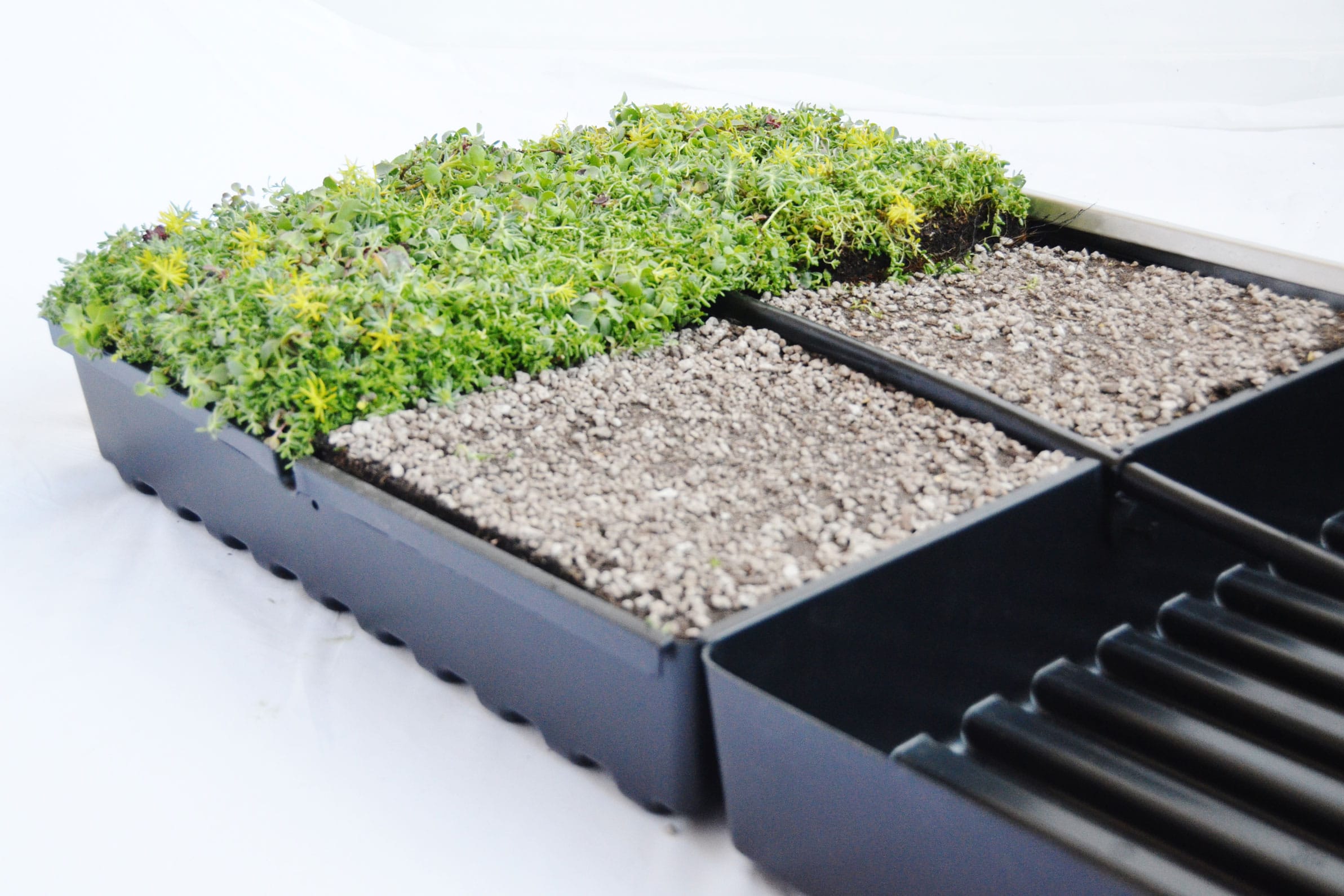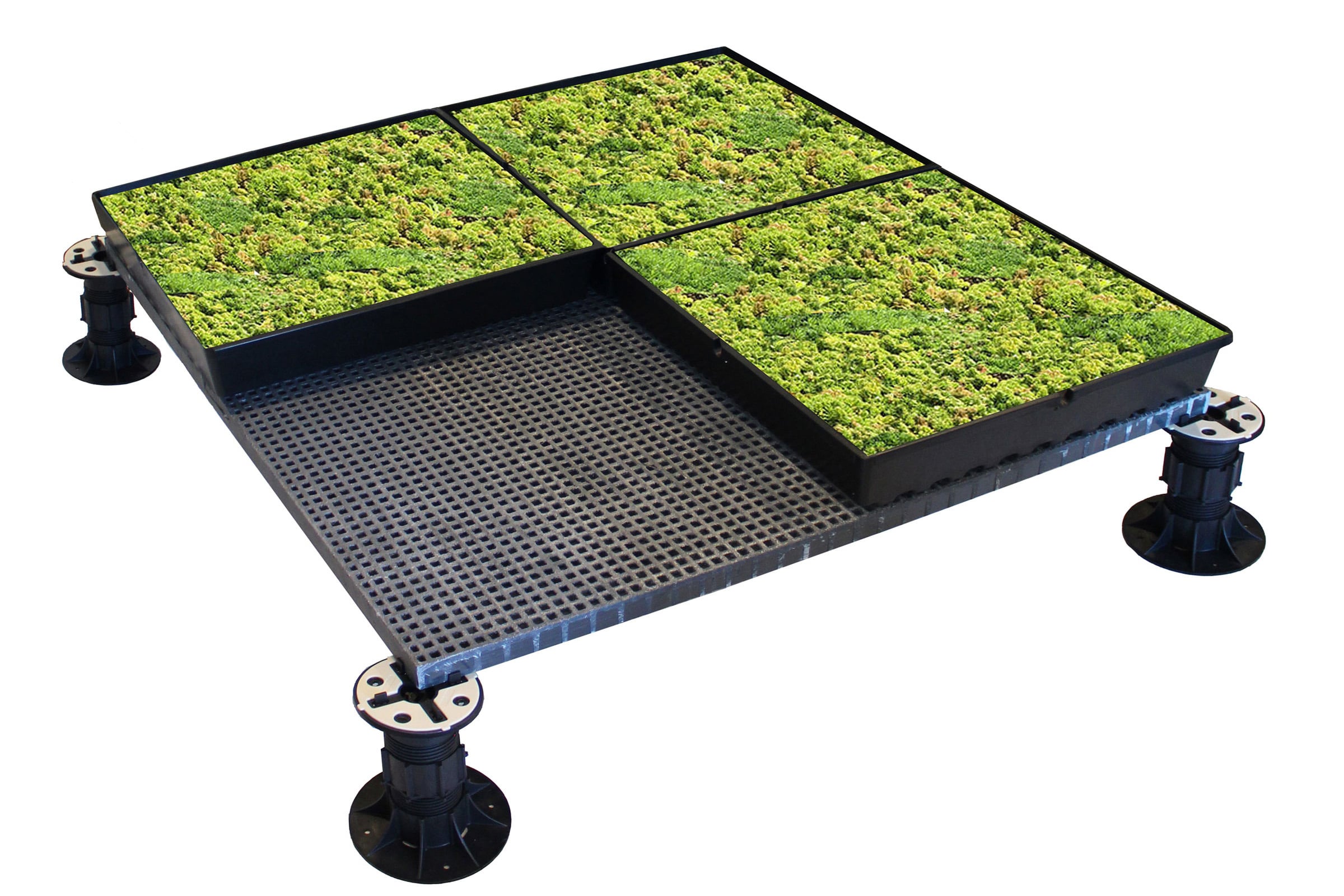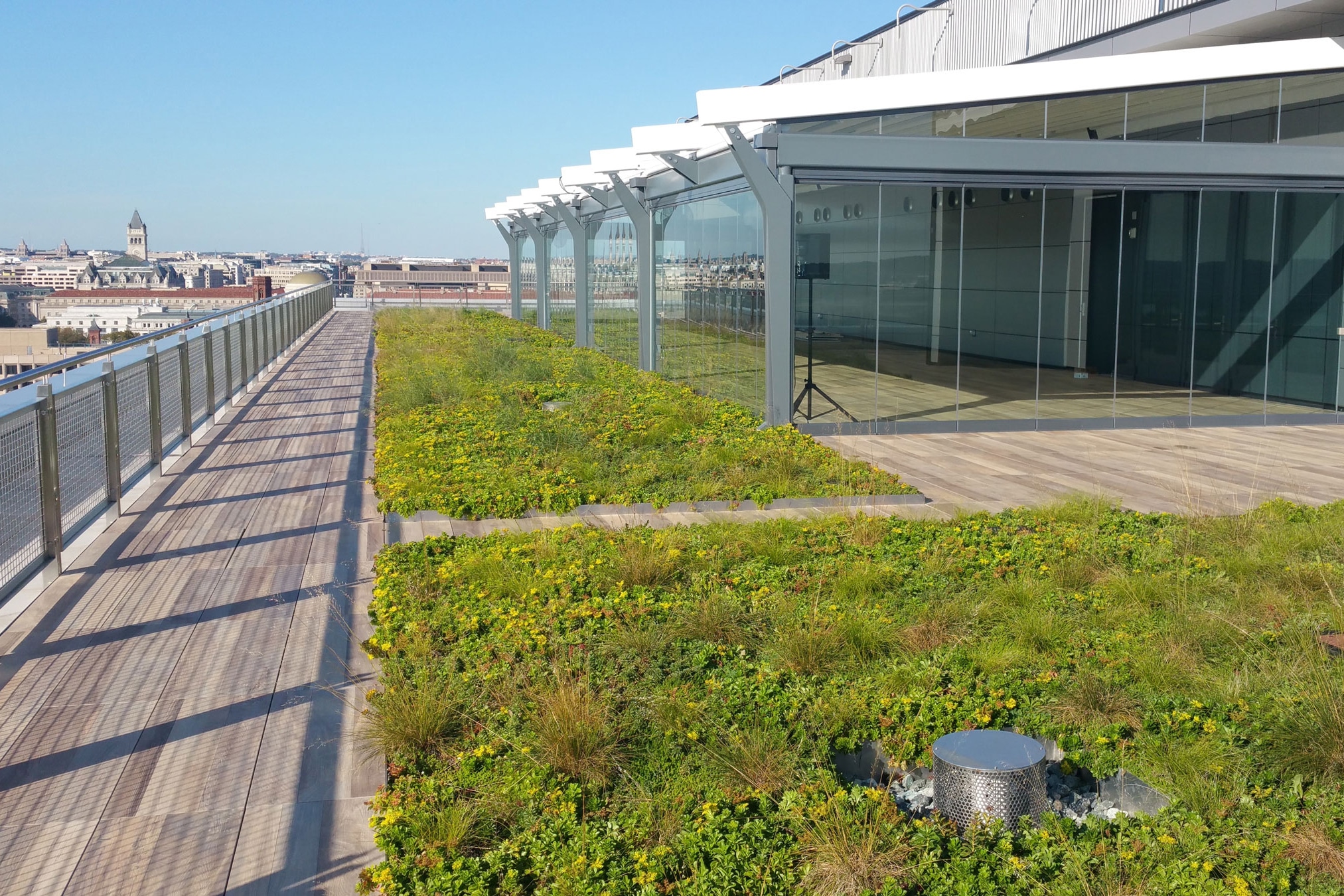Story at a glance:
- Modular plant trays eliminate the need for drainage mats, water retention mats, root barriers, and filter fabric.
- With a tray system you have the option of “pre-grown” or “planted-in-place. Plants are chosen according to climatic zone.
- A green roofing plant tray system is designed to help plants remain healthy, and drip irrigation can easily be connected.
Green roofs have become increasingly popular in recent years with many proven benefits, including better stormwater management, a reduction in urban heat island effect, improvement in air quality, and enhanced urban amenity for building occupants. There is a perception that green roofs are difficult to create, especially for retrofitting on existing buildings, but this is not necessarily true.
Although there are many ways to design a green roof, modular plant trays make it easy. Here’s how.
What is a Green Roof?
Before we get into how to set up a green roof, it’s important to understand its impact on building performance. A green roof is typically defined as a layer of vegetation planted over a waterproof membrane on top of a flat or slightly sloping roof.
A well-designed green roof system enables the sustainability and energy performance of a building to be increased in a number of ways.
Green roof benefits include:
- Reduced roof temperatures, helping to cool the building and reduce heating and cooling bills.
- Reduced and regulated rainfall runoff into stormwater drains.
- Increased plant biodiversity that provides a habitat for insects and birds.
- Protection of the roof membrane, which increases the life of the roof.
- Lowered local air temperature through evapotranspiration, which reduces the urban heat island effect.
How are Green Roofs Designed?
In broad terms, green roofs are categorized as either “extensive” or “intensive.” Extensive green roofs typically have growing media less than 8 inches deep; are relatively lightweight; use small, low-growing plant species such as succulents; require minimal maintenance; and have relatively low water needs. On the other hand, intensive green roofs have a greater depth of planting medium, can support much larger plants with much more variety, and allow the creation of highly engineered landscapes.
Until recently extensive green roofs were not considered to be publicly accessible spaces, while intensive green roofs were understood to be a community amenity spaces for people. Now the boundaries between these categories have become less distinct, especially when roofs combine areas of paving with plantings. Terms like “semi-intensive” or “semi-extensive” are used to describe roofs that include elements of both categories.
What are the Pros and Cons of an Extensive Green Roof?
Extensive green roofs are suitable for retrofitted applications because you need little technical expertise to build them, and they are relatively inexpensive and lightweight. Of particular importance for many building owners, maintenance requirements can be quite low, since plantings are normally allowed to develop naturally.
That said, the lower soil depth can be stressful for plants, which means you have a limited selection of plants to choose from. You also won’t be able to use the planted area for recreation or other uses. Even so, often an extensive green roof is the only viable option for retrofitting a green roof on an existing building.
How Do Modular Plant Trays Improve Extensive Green Roofs?

Planter tray with growing media. Photo courtesy of Columbia Green Technologies
Modular plant trays eliminate the need for drainage mats, water retention mats, root barriers, and filter fabric—all necessary components of growing plants directly on a rooftop.
With a tray system, you have the option of “pre-grown,” where the trays are supplied already filled with growing medium and planted with species like sedums; or “planted-in-place,” where empty trays are laid on the rooftop and then filled with growing medium and plants. Pre-grown tray systems typically require a green roof’s design to be planned in advance and must be installed immediately upon arrival on site. With planted-in-place tray systems, you can install the green roof in phases, as empty plant trays and sacks of growing media are shipped to site and rolls of sedum plantings are shipped separately, which offers more design flexibility.
In both cases plants are specifically selected according to the climatic zone, yet, in all cases, they must be drought tolerant and appropriate for the depth growing medium in the planter trays.
What are the Features of a Modular Plant Tray System?

Planter trays on pedestal supported fiberglass grating panels. Photo courtesy of Archatrak
The main features of a green roofing plant tray system are stormwater management (both retention and controlled release), any design features that will help the plants to remain healthy, how the trays are connected, and how easily drip irrigation can be connected.
For example, plant trays like those produced by Columbia Green Technologies are designed to capture and slowly release peak stormwater flows via a specific pattern of troughs and small drain orifices. These trays are typically capable of retaining an average of 70% of precipitation. The pattern of micro-holes and continuous troughs in the base promotes the air flow necessary for plant growth and root health by preventing overly saturated media. The metered release of water allows plants ample time to uptake water and nutrients from the growing media without sitting in standing water. Some trays are also designed to secure optional drip irrigation which can eliminate the need for hand watering.
To keep the trays from separating or moving in service, some trays are manufactured so the edges overlap and are further secured with pins to create a fully interlocking system. This reduces wind uplift across the entire installation. As well as preventing the trays from shifting, it allows the trays to be overfilled with soil and thus can hide any view of the plastic trays.
Planter trays are either laid directly on the roof top membrane (subject to approval by the membrane supplier or roofing contractor) or on an elevated surface, typically using pedestal supported fiberglass grating panels.
What is the Best Way to Set Up a Green Roof with Planter Trays?
Although there are various ways to use modular planter trays, laying them over a fiberglass grating is one of the most successful and efficient ways set them up. For one, using fiberglass grating ensures a perfectly level surface, which is useful when combining areas of plantings with either access pathways or paved areas. Pipework, electrical conduits, ridges, and other surface irregularities can also be easily hidden under fiberglass panels. In buildings where potential wind uplift is an issue, the open grid structure of fiberglass gratings is extremely resistant to uplift. Where drip irrigation is required, drip lines can be easily laid under the grating, hiding any surface tubing or pipework.
In contrast, elevating trays with products like expanded polystyrene (EPS) foam can be very labor intensive to install, and EPS is a combustible material. Fiberglass grating panels typically weigh around 2.5 pounds per square feet; in comparison, pedestal supported concrete pavers are much heavier, and the total weight of concrete pavers plus filled planter trays can often exceed permitted roof loadings.
How Do Pavers Enhance Green Roof Design?
With an elevated fiberglass grating platform, you can combine practically any type of paver with the planter trays—porcelain pavers, natural stone, concrete pavers, or brick pavers. Normally the gaps between the pavers are left open, but if you prefer the gaps to be filled, that’s no problem. First lay a weed control fabric over the grating; then lay the pavers over the top using spacers to keep the tiles evenly spaced and accurately aligned. You can then fill the gaps with polymeric sand. If you need to raise the paver surface higher so it is level with top of the planter trays, rubber support pads can be placed under the pavers.
If, however, you have large paved area, it’s generally more cost effective to use fiberglass grating panels to support the planter trays only; in this case the pavers would be supported directly with adjustable height pedestals.
Porcelain pavers are normally the best option for paved areas in green roof applications. Not only are they so much lighter than concrete pavers, and hence much easier to move on site and install, but they are also available in an exceptionally wide range of colors and styles that resemble wood, stone, or even concrete.
Although natural wood decking is now prohibited in many urban locations for rooftop decks, where it is still permitted the simplest solution for incorporating a natural wood element in the design is to use structural wood pavers. These can either be laid on the fiberglass panels or supported by adjustable height pedestals.




